
AN ARTIST'S JOURNAL
Welcome to Stanley Roseman - An Artist's Journal

Selections from Stanley Roseman's journal, autobiographical writings, and commentaries.
Roseman's work has received wide critical acclaim, including laudatory reviews in The New York Times and The Times, London, and is represented in important museums and private collections. Recognized as a master draughtsman, Roseman was honored in 1983 as the first American artist to be given a one-man exhibition at the Graphische Sammlung Albertina, Vienna's renowned museum containing one of the world's greatest collections of master drawings.
Edited and prepared for the Internet by Ronald Davis.

Stanley Roseman drawing the dance
from the wings of the stage
of the Paris Opéra, 1994.
from the wings of the stage
of the Paris Opéra, 1994.
''STANLEY ROSEMAN combines an innate artistic talent, expressed through a wide range of techniques, with a profound interest in the human condition in portraying different kinds of people, professions, social or artistic groups. With a seriousness that pushes him always further in treating a subject or theme, he continually clarifies and refines, never letting his interest waiver or diminish.''
- Bibliothèque Nationale de France
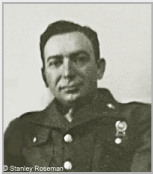
AN ARTIST'S JOURNAL
"From my early years, my father was of great support and encouragement to me in my love for drawing, painting, and sculpting. My father's strong and loving presence in my youth gave me the strength and conviction to pursue my desire to be an artist and follow my own course in life.''
Bernard Roseman
1908 - 1964
1908 - 1964
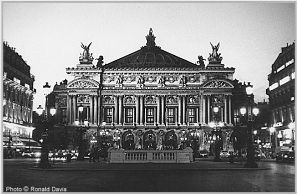
Paris Opéra, Palais Garnier
To accompany his drawings, Roseman has written about his work at the Paris Opéra, from his invitation in 1989 and through the 1990's. The artist also provides historical information on that great, cultural institution and its important contribution to the development of classical ballet. He speaks about his working methods and his love for the dance and acknowledges: "To the dancers, who have given me inspiration for my work, I express my profound gratitude." On the Journal website page Roseman recounts his first days of drawing the dance at the Paris Opéra.
At the Circus - My Friendship with Frosty Little
Director of Clowns, Ringling Bros.and Barnum & Bailey Circus
Director of Clowns, Ringling Bros.and Barnum & Bailey Circus
Frosty Little, 1977
Director of Clowns
Ringling Bros. and Barnum & Bailey Circus
Oil on Strathmore paper, 73 x 58 cm
Musée des Beaux-Arts, Bordeaux
Director of Clowns
Ringling Bros. and Barnum & Bailey Circus
Oil on Strathmore paper, 73 x 58 cm
Musée des Beaux-Arts, Bordeaux
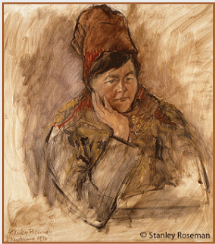
Roseman remembers with appreciation Bier Ante Ris'ten for her encouragement of his work and for introducing the artist to members of her family, who kindly sat for their portraits, as did Ris'ten herself.
Bier Ante Ris'ten, 1976
Oil on canvas, 98 x 80 cm
Collection of Ronald Davis
Oil on canvas, 98 x 80 cm
Collection of Ronald Davis
''Circus clowns are one of the glittering joys of all of our lives, whether we are young or old,'' states The New York Times in its superlative review entitled ''Spirit of the Clown'' dedicated to Roseman's work created during his sojourns with the Ringling Bros. and Barnum & Bailey Circus.
"Paintings by Stanley Roseman glow with a shiny dignity"
- The New York Times
"The Saami paintings are magnificent."
Roseman's interest in the nomadic Saami as a subject for his work took him in 1976 to Norwegian Lappland. There, beyond the Arctic Circle, the artist painted portraits of the Saami, an independent, reindeer-herding people who maintain their centuries-old, nomadic way of life.
Remembering the Octogenarian Trappist Monk Father Benedict
Mount St. Bernard Abbey, England
Mount St. Bernard Abbey, England
Correct Usage of the Word "Monk"
in reference to male members of religious orders in the Western Church
in reference to male members of religious orders in the Western Church
Roseman's landscapes express a deep feeling for Nature and constitute a major part of the artist's oeuvre.
December Morning -
View from Chardonne Overlooking Lake Geneva, 1987
Oil on panel, 16 x 39.5 cm
Musée des Beaux-Arts, Rouen
View from Chardonne Overlooking Lake Geneva, 1987
Oil on panel, 16 x 39.5 cm
Musée des Beaux-Arts, Rouen
"truly beautiful landscape painting"
- Anzeiger von Saanen, Gstaad
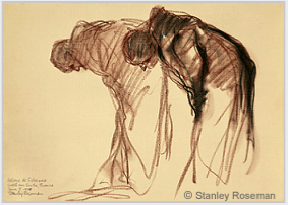
Two Monks Bowing in Prayer, 1979
Benedictine Abbey of Solesmes,
France
chalks on paper, 35 x 50 cm
National Gallery of Art, Washington, D.C.
Benedictine Abbey of Solesmes,
France
chalks on paper, 35 x 50 cm
National Gallery of Art, Washington, D.C.
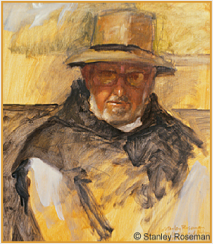
"At my first Trappist monastery that spring and summer of 1978, I had the memorable experience of a friendship with Father Benedict and painting a portrait of the genial, eighty-four-year-old Scotsman with an endearing sense of humor and of great kindness and deep spirituality."
Father Benedict,
Portrait of a Trappist Monk, 1978
Mount St. Bernard Abbey, England
Oil on canvas, 80 x 60 cm
Private collection
Portrait of a Trappist Monk, 1978
Mount St. Bernard Abbey, England
Oil on canvas, 80 x 60 cm
Private collection
Behind the monastery walls where Roseman was invited to share in the day-to-day life in the cloister, he created an unprecedented oeuvre of paintings and drawings on the monastic life.
An Audience with Pope John Paul II
Vatican, March 21, 1979
Vatican, March 21, 1979
Pope John Paul II receiving Roseman and Davis
at the Vatican on the feast day of St. Benedict,
March 21, 1979.
at the Vatican on the feast day of St. Benedict,
March 21, 1979.
"Stanley, your beautiful paintings and drawings devoted to contemplation and prayer promote a spirit of friendship and understanding between Christians and Jews and all people of goodwill."
- Pope Saint John Paul II
Taking hold of the artist's arm as they spoke and expressing his admiration for the scope and spiritual depth of Roseman's work on the monastic life, the Pope said:
The Journal website page recounts an audience with Pope John Paul II at the Vatican when Roseman and Davis presented the Pontiff with a gift of the artist's drawing from the Benedictine Abbey of Tyniec, near Krakow.
The sentence quoted above is from Roseman's text entitled "On Drawing and the Dance'' from the fine art book Stanley Roseman and the Dance - Drawings from the Paris Opéra, published Paris, 1996. This website page presents selections from the artist's text, accompanied by his drawings.
"Stanley Roseman's drawings show the many facets
of his great talents as a draughtsman."
of his great talents as a draughtsman."
- Bibliothèque Nationale de France
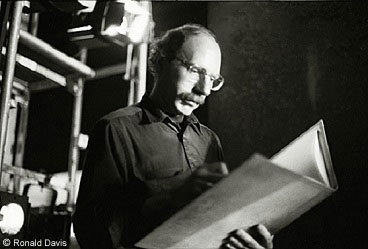
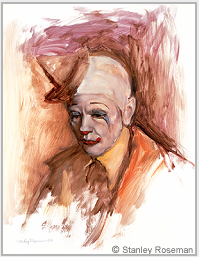
Nicolas Le Riche, 1995, Paris Opéra Ballet
Pencil on paper, 38 x 28 cm,
British Museum, London
Pencil on paper, 38 x 28 cm,
British Museum, London
The respected art journal ARA arte religioso actual, Madrid, published in the fall of 1979 a laudatory reportage entitled ''Stanley Roseman y la Vida Monastica'' and states:
''The pictures - splendid and telling all at once - form the stimulating vanguard towards so original and deep a study of the monastic life.''
- ARA arte religioso actual, Madrid
The Italian Renaissance of the fifteenth century saw the emergence of autobiographical writings by an artist with Ghiberti's Commentaries, Book II. In the following century, Dürer records his travels abroad in Diary of a Journey to the Netherlands, and Cellini recounts his life in what has become a widely-read autobiography. Vasari, the celebrated sixteenth-century Florentine architect, painter, and biographer of Lives of the Artists, also writes of himself and his work in his Ragionamenti, or "Description," which he appended to the Lives. As Dürer did with his Netherlands diary, Gauguin relates his sojourn on Tahiti from 1891 to 1893 in his journal Noa Noa. Delacroix's Journal, written from 1822 to 1863, comprises three volumes; and Van Gogh's many letters over the years to his brother Theo constitute, in effect, an autobiography of the artist. In the twentieth century, artists' reminiscences include, to mention three, Rouault's Souvenirs intimes, Benois' Memoirs, and Chagall's Ma Vie.
Selections
See Journal Selections below
Roseman's journal and autobiographical writings include the artist's memorable experiences in the exciting world of the performing arts, in particular, opera, theatre, dance, circus, and the concert stage; his travels beyond the Arctic Circle to Lappland, where he painted portraits of nomadic Saami people; and his sojourns in Benedictine, Cistercian, Trappist, and Carthusian monasteries throughout Europe, which resulted in an extensive oeuvre of paintings and drawings on the monastic life - a life centered on contemplation and prayer and the singing of the Psalms. Landscapes are also an important part of Roseman's oeuvre, and the artist writes of painting and drawing en plein air, from seacoasts to rolling pastures, woodlands, and mountainous terrain.
Roseman covers a wide range of subjects and events in diary entries and memoirs. He writes on his working methods and his beliefs on art. Roseman writes with sincere gratitude of those who have been of encouragement to him in his career and have expressed appreciation and praise for his work. He also strongly confronts his detractors who inevitably appear in the life of an artist who has gone his own way counter to the dominant art movements of his time. Roseman pays homage to those who have been deeply meaningful in his life, to steadfast friends, and to art collectors who have made his life as an artist possible.
"Spring, summer, and fall," writes the artist, "can be very pleasant times of the year to be at my easel or with my drawing book on a grassy hillside or in a secluded valley. But when the North Wind brings ever colder days, I willingly endure the cold for the inspiration that also comes from painting and drawing en plein air in winter.''
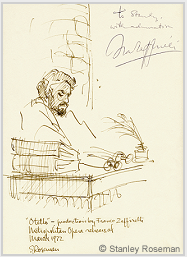
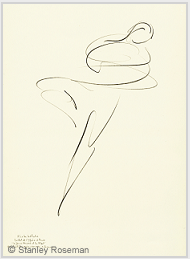
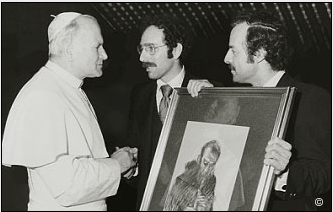
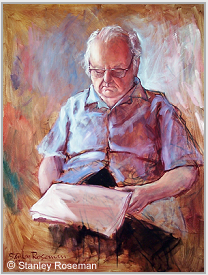
An Invitation to Draw at the Metropolitan Opera
With a cordial invitation from the administration of the Metropolitan Opera in 1972, Roseman began an extensive work on the performing arts, a work that culminated with the American Bicentennial exhibition Stanley Roseman - The Performing Arts in America. The exhibition, encompassing opera, theatre, dance, and the circus, toured the United States from December 1975 through 1976 and concluded at the Library and Museum for the Performing Arts, Lincoln Center, New York City, winter-spring, 1977.
James McCracken as Otello in the production by Franco Zeffirelli
1972, Metropolitan Opera
Otello
Pen and bistre ink, 35 x 27 cm
Collection of the artist
1972, Metropolitan Opera
Otello
Pen and bistre ink, 35 x 27 cm
Collection of the artist
On the Journal website page Roseman recounts drawing at the dress rehearsal of Zeffirelli's production of Verdi's Otello and the memorable meeting with the eminent Director.
Presented here is Roseman's impressive pen and bistre ink drawing that Franco Zeffirelli graciously autographed and inscribed:
On Portraiture
"a magnificent painting of the composer''
- American Symphony Orchestra
Virgil Thomson, 1972
Oil on canvas, 101 x 76 cm
Collection of the artist
Oil on canvas, 101 x 76 cm
Collection of the artist
- The Times, London
''To Stanley, with admiration
Franco Zeffirelli"
Franco Zeffirelli"
Portraiture holds an important place in Roseman's oeuvre and has brought him great esteem in his career. Aftonbladet, Stockholm, the leading Swedish newspaper, published in its Sunday magazine a cover story on the artist and commends Roseman for creating portraits "artistically on a high level as well as accurately expressive of the human dimension.''
The first of three selections on this journal website page dedicated to portraiture is from Roseman's recollections of his memorable experience painting a portrait of the Pulitzer Prize winning American composer Virgil Thomson. The portrait was exhibited at Carnegie Hall on the occasion of the eminent composer's 80th birthday celebration and the New York premiere of his Symphony No. 3 performed by the American Symphony Orchestra on December 26, 1976. The press release for the occasion praises the Roseman portrait of Virgil Thomson:
"Use of a copyright protected work without its owner's permission may be a civil infringement and/or a criminal offence depending on the circumstances."
- Intellectual Property Office
United Kingdom
United Kingdom
On the Journal page, Roseman confronts the offenders responsible for the copyright infringement and indicates the websites that published the drawing without his authorization and have eliminated his signature from the drawing.
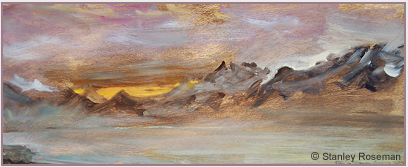
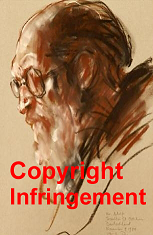
Notice of Copyright Infringement
and the elimination of Roseman's signature from his drawing
and the elimination of Roseman's signature from his drawing
Roseman's critically acclaimed oeuvre on the monastic life comprises the Benedictine, Cistercian, Trappist, and Carthusian Orders - the four monastic orders of the Western Church. The artist's ecumenical work, begun in 1978 and realized in the enlightenment of the Second Vatican Council, depicts monks and nuns of the Roman Catholic, Anglican, and Lutheran faiths. This extensive work includes over sixty monasteries in Europe.
''No one, I believe, in 1,500 years of Christian monachism has catalogued, defined and described so clearly or so beautifully the business of the monastic life. No writer, no sculptor, no painter, no architect has refined a distillation so pure, so accurate, so breathtakingly clear as Roseman has done.''
- The Times, London
The page provides brief descriptions of the Monastic Orders and other religious Orders in the Western Church.
A Carthusian Monk
at Vigils, 1982
Chartreuse de la Valsainte,
Switzerland
Chalk on paper, 50 x 35 cm
Musée Ingres, Montauban
at Vigils, 1982
Chartreuse de la Valsainte,
Switzerland
Chalk on paper, 50 x 35 cm
Musée Ingres, Montauban
Roseman's work on the monastic life includes drawings of monks and nuns at Vigils, the first and the longest of the canonical hours. The artist writes about drawing at the Night Office and about the ancient Judeo-Christian tradition of psalmody in monastic life.
A Carthusian Monk at Vigils, 1982, Chartreuse de la Valsainte, Switzerland, presented here, is conserved in the Musée Ingres, Montauban.
"I am, for what is meaningful to me, very sensitive to the purity
and the profound interiority expressed in this work of art.''
and the profound interiority expressed in this work of art.''
- Pierre Barousse, Curator
Musée Ingres, Montauban
Musée Ingres, Montauban
Roseman offers information on Vigils in early monastic communities of the Middle East: the Jewish monastic settlement at Qumran, near the Dead Sea; and the Therapeutae, or Jewish eremites, near Alexandria, both of which flourished from the second century BC to the first century AD. Roseman speaks of the Desert Fathers, fourth-century Christian monks in Egypt, and on the observance of the Night Office as prescribed in the Rule of St. Benedict.
This drawing by Stanley Roseman is reproduced and disseminated on the Internet without the artist's permission. The image seen on the Internet is presented here along with a notice by the artist indicating "Copyright Infringement." Those responsible for this copyright infringement have published the drawing with the artist's signature eliminated from the lower right side of his drawing. Furthermore, the offenders are publishing incorrect information regarding the Roseman drawing.
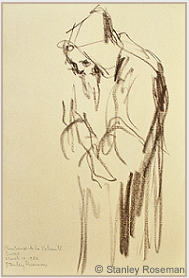
Copyright Infringement.
This drawing by
Stanley Roseman
is reproduced and
disseminated on the Internet
without the artist's authorization.
This drawing by
Stanley Roseman
is reproduced and
disseminated on the Internet
without the artist's authorization.
Roseman's signature has been eliminated from the lower right side of his drawing.
Roseman raises questions concerning the English auction house Rosebery's that has grossly undervalued this drawing from the artist's critically acclaimed work on the monastic life. Roseman's work earned him the honor of being the first American artist to have a one-man exhibition at the world-renowned Albertina.
The Prophet states in the Book of Psalms: "At midnight I rise to praise you, O Lord.''
In the summer of 1978, Stanley Roseman and Ronald Davis were in Holland where they met a Dutch couple Arie and Ennie Meesters - a fortuitous occurrence of great significance in the early months of the artist's work on the monastic life.
Arie and Ennie Meesters were of the Protestant faith, Ronald Davis is of the Roman Catholic faith, and Stanley Roseman, of the Jewish faith. The friendship between the Dutch couple and the American partners fostered ecumenicism with which the artist and his colleague had begun their work in the monasteries.
Ennie and Arie Meesters at their home
in Haarlem, the Netherlands, 1979.
in Haarlem, the Netherlands, 1979.
For five seasons at the Metropolitan Opera, Roseman drew at dress rehearsals and performances of productions from the exciting world of opera.
The Meesters were about to trade in their Peugeot for a newer model. The kindhearted Dutch couple offered their present car to Roseman and Davis to facilitate their travels to monasteries and help bring to realization Roseman's oeuvre on the monastic life.
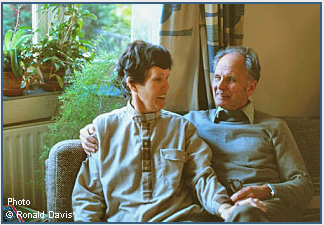
You are cordially invited to also visit:
www.stanleyroseman-monasticlife.com
and
www.stanleyrosemandance.com
www.stanleyroseman-monasticlife.com
and
www.stanleyrosemandance.com
Stanley Roseman - An Artist's Journal republished in 2016 with additional text and imagery.
Please note that the websites were prepared for Internet Explorer 11.
Copyright © Stanley Roseman and Ronald Davis, 2014, 2016 - All Rights Reserved
Visual imagery and website content may not be reproduced in any form whatsoever.
Visual imagery and website content may not be reproduced in any form whatsoever.
